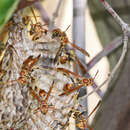en
names in breadcrumbs


Mischocyttarus is a very large, primarily Neotropical genus of social wasps with a few species found also in the Nearctic region. It is the only member of the tribe Mischocyttarini;[1] the asymmetrical tarsal lobes of Mischocyttarus separates it from the tribe Epiponini. Mischocyttarus is the largest genus of social wasps, containing over 200 species and subspecies.[1] Mischocyttarus wasps build a relatively simple, single comb nest. Sometimes, the nest is built within a meter of the nest of Polistes carnifex.[2] Foraging adults bring nectar and small caterpillars back to the nest to feed to the developing larvae which are individually housed in separate cells in the nest.[3] Not all nests have a female with developed ovaries.[2] Their biology is similar to that of species in the genus Polistes. However, Mischocyttarus appear to show considerably more social and reproductive flexibility than Polistes.

Mischocyttarus is a very large, primarily Neotropical genus of social wasps with a few species found also in the Nearctic region. It is the only member of the tribe Mischocyttarini; the asymmetrical tarsal lobes of Mischocyttarus separates it from the tribe Epiponini. Mischocyttarus is the largest genus of social wasps, containing over 200 species and subspecies. Mischocyttarus wasps build a relatively simple, single comb nest. Sometimes, the nest is built within a meter of the nest of Polistes carnifex. Foraging adults bring nectar and small caterpillars back to the nest to feed to the developing larvae which are individually housed in separate cells in the nest. Not all nests have a female with developed ovaries. Their biology is similar to that of species in the genus Polistes. However, Mischocyttarus appear to show considerably more social and reproductive flexibility than Polistes.
 Mischocyttarus mexicanus cubicola huddling together in early winter
Mischocyttarus mexicanus cubicola huddling together in early winter